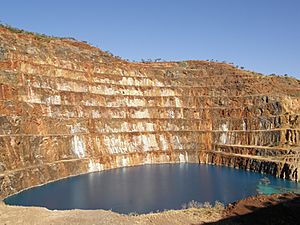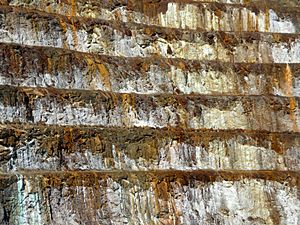Mary Kathleen, Queensland facts for kids
Mary Kathleen was a special mining town in north-western Queensland, Australia. It was built in the Selwyn Range, located between the towns of Mount Isa and Cloncurry. This unique town was created specifically to support a large uranium mine.
Contents
History of Mary Kathleen
Mary Kathleen was first settled in the 1860s. However, its main story began in 1954 when two men, Clem Walton and Norm McConachy, found uranium there. The mine and the town were named after McConachy's late wife, Mary Kathleen.
Soon after, a company called Rio Tinto Mining formed Mary Kathleen Uranium Ltd in 1955. Their goal was to build a mine and a town for the workers. From 1956 to 1958, a carefully planned town was built. It even had its own water supply from a dam called Lake Corella.
St Peter's Catholic Church was built in 1958. When the town closed, the church building was moved. It became a shelter at Saint Joseph’s Catholic School in Mount Isa.
The Uranium Mine
The large uranium deposit was found in 1954. In 1956, a deal was made to sell uranium to the United Kingdom. Mining started in late 1956, and a plant to process the ore began working in June 1958.
Mary Kathleen Uranium Limited (MKU) developed the project. They built the town, the mine, and a dam on the Corella River. The uranium was dug out using an open-cut method, like a giant pit. The ore was then processed right there at the mine.
First Mining Period
From 1958 to 1963, the mine processed 2.9 million tonnes of ore. This produced about 3,460 tonnes of uranium. By 1963, the main sales contract was finished early. Because of this, the mine and town were temporarily closed down.
Second Mining Period
The mine stayed closed until 1974. It then reopened to fulfill new contracts with companies in Japan, Germany, and America. The Australian government also became a major owner of the company.
The second period of mining began in 1976. The mine finally closed in 1982 when all the uranium was used up. In total, 31 million tonnes of ore were taken from the mine.
The Mary Kathleen Town
The town was built about 6 kilometres (3.7 mi) from the mine. It was designed to fit into the valley. The town had many facilities for its residents.
It included a post office, a cinema, and sports fields. There was also a school, banks, and a community store. The state school opened in July 1956. Water from Lake Corella Dam started flowing to the town in May 1957. By 1961, about 1,000 people lived in Mary Kathleen.
The Australian Broadcasting Corporation (ABC) even had a special relay station for the town. This station, called ABMKQ, closed when the town was abandoned.
Mary Kathleen was a very well-planned town. It was designed to blend in with the natural environment.
Town Growth and Services
When the mine reopened in 1974, the town's population grew quickly. It went from 80 people in August 1974 to 700 people in August 1975. The population reached its highest point of about 1,200 people in 1981.
During this "second life," the town's buildings and services were updated. New additions were also made for the community.
Sport in Mary Kathleen
Mary Kathleen has a unique place in Australian sports history. The town had an Australian Rules football club. This club won three championships in a row from 1977 to 1979.
It is rare for a club from a town that no longer exists to have won such titles.
Closure of Mary Kathleen
By late 1982, all the uranium contracts were completed. The town, mine, and processing plant were then taken apart. The area was cleaned up by the end of 1984.
Mary Kathleen became Australia's first major project to clean up a uranium mine site. This work was finished in 1985 and cost about A$19 million. In 1986, the cleanup work won an award for being excellent for the environment.
Today, the site is known for finding gemstones. Many items from the town are kept at the Cloncurry/Mary Kathleen Memorial Park and Museum in Cloncurry. The site now only has roads and concrete pads. It can be visited as a camp spot from the Barkly Highway. The land has been restored and is now used for grazing animals.
Tailings Seepage
After the cleanup, it was found that the area where the mine waste was stored had some issues. Radioactive water was seeping out from the waste area. This was happening at a faster rate than expected.




